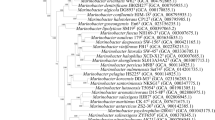Abstract
Two strains capable of degrading cyclohexane were isolated from the soil and sludge of the wastewater treatment plant of the University of Stuttgart and a biotrickling filter system. The strains were classified as gram negative and identified as Acidovorax sp. CHX100 and Chelatococcus sp. CHX1100. Both strains have demonstrated the capability to degrade cycloalkanes (C5–C8), while only strain CHX1100 used as well short linear n-alkanes (C5–C8) as the sole source of carbon and energy. The growth of Acidovorax sp. CHX100 using cyclohexane was much faster compared to Chelatococcus sp. CHX1100. Degenerated primers were optimized from a set sequences of cyclohexanol dehydrogenase genes (chnA) as well as cyclohexanone monooxygenases (chnB) and used to amplify the gene cluster, which encodes the conversion of cyclohexanol to caprolactone. Phylogenetic analysis has indicated that the two gene clusters belong to different groups. The cyclohexane monooxygenase-induced activity which oxidizes also indole to 5-hydroxyindole has indicated the presence of a CYP-type system monooxygenase involved in the transformation of cyclohexane to cyclohexanol.






Similar content being viewed by others
References
Anderson MS, Hall R, Griffin M (1980) Microbial metabolism of alicyclic hydrocarbons: cyclohexane catabolism by a pure strain of Pseudomonas sp. J Gen Microbiol 120:89–94
Cheng Q, Thomas SM, Kostichka K, Valentine JR, Nagarajan V (2000) Genetic analysis of a gene cluster for cyclohexanol oxidation in Acinetobacter sp. strain SE19 by in vitro transposition. J Bacteriol 17:4744–4751
Cox HHJ, Deshusses MA (2002) Co-treatment of H2S and toluene in a biotrickling filter. Chem Eng J 87(1):101–110
de Klerk H, van der Linden AC (1974) Bacterial degradation of cyclohexane participation of a co-oxidation reaction. Ant van Leeuw 40:7–15
Dobslaw D, Engesser KH (2012) Degradation of 2-chlorotoluene by Rhodococcus sp. OCT 10. Appl Microbiol Biotechnol 93:2205–2214
European Union (EU) (2004) Risk assessment report cyclohexane, CAS no: 110-82-7
Kulakova AN, Stafford TM, Larkin MJ, Kulakov LA (1995) Plasmid pRTL1 controlling 1-chloroalkane degradation by Rhodococcus rhodochrous NCIMB13064. Plasmid 33:208–217
Lee EH, Cho KS (2008) Characterization of cyclohexane and hexane degradation by Rhodococcus sp. EC1. Chemosphere 71:1738–1744
Lee S, Oh H, Kim O (2013) Isolation and characterisation of volatile organic compounds-degrading Bacillus strains from Loess. J Environ Protect 4:50–57
McClay K, Boss C, Keresztes I, Steffan RJ (2005) Mutations of toluene-4-monooxygenase that alter regiospecificity of indole oxidation and lead to production of novel indigoid pigments. Appl Environ Microbiol 71:5476–5483
Opere BO, Obayori OS, Raji AA (2013) Degradation of cyclohexane and cyclohexanone by Bacillus lentus strain LP32. Afr J Biotechnol 12(47):6632–6635
Park SH, Kim DH, Kim D, Kim DH, Jung HC, Pan JG, Ahn T, Kim D, Yun CH (2010) Engineering bacterial cytochrome P450 (P450) BM3 into a prototype with human P450 enzyme activity using indigo formation. Drug Metab Dispos 38(5):732–739
Perry JJ (1984) Microbial metabolism of cyclic alkanes. R.M. Atlas (Ed.), Petroleum. Microbiology 61–67
Prokop Z, Monincová M, Chaloupková R, Klvana M, Nagata Y, Janssen DB, Damborský J (2003) Catalytic mechanism of the haloalkane dehalogenase LinB from Sphingomonas paucimobilis UT26. J Biol Chem 278:45094–45100
Qing-Shan L, Schwaneberg U, Fischer P, Schmid RD (2000) Directed evolution of the fatty-acid hydroxylase P450 BM-3 into an indole-hydroxylation catalyst. Chem Eur J 6:1531–1536
Rouviere PE, Chen MW (2003) Isolation of Brachymonas petroleovorans CHX, a novel cyclohexane-degrading β-proteobacterium. FEMS Microbiol Lett 227:101–106
Salamanca D, Strunk N, Engesser KH (2013) Chromate reduction in anaerobic systems by bacterial strain Pseudomonas aeruginosa CRM100. Chemie Ingenieur Technik 85:1575–1580
Sardessai YN, Bhosle S (2004) Industrial potential of organic solvent tolerant bacteria. Biotechnol Progress 20:655–660
Schanstra JP, Janssen DB (1996) Kinetics of halide release of haloalkane dehalogenase: evidence for a slow conformational change. Biochemistry 35:5624–5632
Stirling LA, Watkinson RJ (1977) Microbial metabolism of alicyclic hydrocarbons: isolation and properties of a cyclohexane-degrading bacterium. J Gen Microbiol 99:119–125
Sugimori D, Sekiguchi T, Hasumi F, Kubo M, Shirasaka N, Ikunaka M (2004) Microbial hydroxylation of indole to 7-hydroxyindole by Acinetobacter calcoaceticus strain 4-1-5. Biosci Biotechnol Biochem 68(5):1167–1169
Trower MK, Buckland MB, Higgins R, Griffin M (1985) Isolation and characterization of a cyclohexane-metabolizing Xanthobacter sp. Appl Environ Microbiol 49:1282–1289
US Environmental Protection Agency (EPA) (1994) Chemical summary for cyclohexane. Washington D.C
Warburton EJ, Magor AM, Trower MK, Griffin M (1990) Characterization of cyclohexane hydroxylase; involvement of a cytochrome P-450 system from a cyclohexane grown Xanthobacter sp. FEMS Microbiol Lett 66:5–9
Yang C, Yu G, Zeng G, Yang H, Chen F, Jin C (2011) Performance of biotrickling filters packed with structured or cubic polyurethane sponges for VOC removal. J Environ Sci 23:1325–1333
Yi T, Lee EH, Ahn YG, Hwang GS, Cho KS (2011) Novel biodegradation pathways of cyclohexane by Rhodococcus sp. EC1. J Hazard Mater 191(1–3):393–396
Acknowledgements
We thank Prof. Dr. Andreas Schmidt, PD Dr. Katja Bühler and Rohan Karande from the Laboratory of Chemical Biotechnology, TU Dortmund University, for sharing their expertise in the field of biodegradation process.
Author information
Authors and Affiliations
Corresponding author
Additional information
Responsible editor: Robert Duran
Rights and permissions
About this article
Cite this article
Salamanca, D., Engesser, KH. Isolation and characterization of two novel strains capable of using cyclohexane as carbon source. Environ Sci Pollut Res 21, 12757–12766 (2014). https://doi.org/10.1007/s11356-014-3206-z
Received:
Accepted:
Published:
Issue Date:
DOI: https://doi.org/10.1007/s11356-014-3206-z




